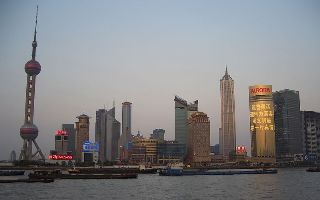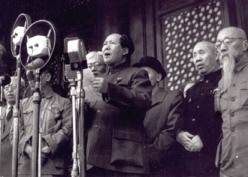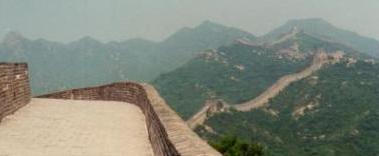History >> Geography >> Asia >>
China
China
Timeline and History Overview
China Timeline
Most of Chinese history can be divided up into a series of dynasties from the start of the Xia dynasty in 2205 BCE to the end of the Qing dynasty in 1912 CE. You can go here to learn more about Ancient China.
BCE
Xia Dynasty (2205 to 1575)
Shang Dynasty (1570 to 1045)
Zhou Dynasty (1045 to 256)
- 771 - Start of the Spring and Autumn Period and the rise if the Eastern Zhou.
- 551 - The Chinese philosopher Confucius is born. His thoughts and ideas will have a great impact on the culture of China.
Qin Dynasty ( 221 to 206)

The Terracotta Army
- 221 - The first emperor of China, Emperor Qin, unites all of China under one rule.
- 220 - Construction on the Great Wall of China begins in an effort to keep out the Mongols.
- 210 - Emperor Qin dies and is buried with the Terra Cotta Army.
Han Dynasty (206 BCE to 220 CE)
CE
- 105 - Paper is invented by Cai Lun.
- 208 - The Battle of Red Cliffs occurs.
Six Dynasties (222 to 581)
- 250 - The religion of Buddhism is introduced. It will become one of the three main religions of China.
Sui Dynasty (589 to 618)
- 609 - The Grand Canal is finished.
Tang Dynasty (618 to 907)
- 868 - The first use of wood block printing to print a book.
Five Dynasties (907 to 960)
Song Dynasty (960 to 1279)
- 1044 - Gunpowder is invented. It is first used for fireworks.
- 1088 - The Chinese invent the magnetic compass.
- 1200 - The Mongol tribes are united under Genghis Khan. He begins his conquest of northern China.
Yuan Dynasty (1279 to 1368)
- 1279 - Mongol leader Kublai Khan defeats the Chinese and takes control of the land. He forms his own dynasty called the Yuan dynasty.
Ming Dynasty (1368 to 1644)
- 1405 - Explorer Zheng He makes his first journey to India and Africa. The construction on the Forbidden City begins.
- 1420 - Beijing is made capital of China.
- 1517 - The Portuguese arrive and establish trade with China.

Skyline of Shanghai
Qing Dynasty (1644 to 1912)
- 1900 - The Boxer Rebellion occurs with violence against foreigners and Christians. International forces intervene.
- 1908 - Puyi becomes the last Emperor of China at the age of 2.
- 1910 - Slavery is abolished in China.
- 1911 - The Qing dynasty is overthrown by the Xinhai Revolution.
Republican Era (1912 to 1949)
- 1912 - Revolutionary Sun Yat-sen becomes the first President of the Republic of China.
- 1912 - China adopts the Gregorian Calendar.
- 1917 - China joins World War I and declares war on Germany.
- 1927 - The Ten Years Civil War occurs between the Kuomintang nationalists, led by Chiang Kai-shek, and the communist party, led by Mao Zedong.
- 1928 - Chiang Kai-shek becomes the Chairman of the National Government of China.
- 1934 - Mao Zedong leads his people on a retreat across China called the Long March.
- 1937 - China is invaded by Japan. Japan captures several important cities including Beijing.
- 1941 - Japan attacks the United States at Pearl Harbor. China is now on the side of the Allies in World War II.
- 1945 - World War II comes to an end and Japan is defeated. The Civil War between the communists and the nationalists resumes.
Communist Era (1949 to present)

Mao Zedong
- 1949 - The communists win the war and the People's Republic of China is formed by Mao Zedong.
- 1949 - The nationalists flee to Taiwan and set up their government.
- 1958 - Beginning of the "Great Leap Forward." The plan fails and millions starve to death.
- 1964 - China develops a nuclear bomb.
- 1966 - Mao begins his "Cultural Revolution" in which over one million people are killed.
- 1972 - President Richard Nixon visits China.
- 1974 - The Terra Cotta Warriors are discovered.
- 1984 - The communist party allows for economic reforms with less government involvement in business.
- 1997 - The United Kingdom hands over control of Hong Kong to China.
- 2006 - The Three Gorges Dam is completed.
- 2008 - The summer Olympics are held in Biejing.
- 2010 - China becomes the world's second largest economy behind the United States.
Brief Overview of the History of China
China's history is rich with art, politics, science, and philosophy. It is home to the oldest of the major world civilizations.
China was ruled by various dynasties for much of its history. The first dynasty is believed to be the Xia dynasty which formed somewhere around 2250 BC. The Shang or Yin dynasty gained power around the 14th century BC. The Han Dynasty, which lasted over 400 years from 206 BC to 220 AD, was one of the most influential in China's history. Much of the culture today was created during the Han Dynasty. Later famous dynasties, like the Song and the Tang, continued to refine the culture and bring new innovations to the world including printed money, a permanent navy, and a complex government that ruled over 100 million people.

The Great Wall of China
The last of the great dynasties, the Qing Dynasty, began in 1644. The Ming Dynasty was in power, but was overthrown by the Manchus who put the Qing dynasty into power. During the Qing dynasty, western influences, European trade, and a number of wars all served to weaken China. Great Britain gained control of Hong Kong after the Opium Wars.
In the early 1900s the people of China began to want reform. Revolutionary leader Sun Yat-sen created the Chinese Nationalist Peoples Party, also called the KMT or Kuomintang. After Sun Yat-sen died, Chiang Kai-shek became leader of the party. However, Chiang turned on the leaders of the CCP, the communist party, and had many of them killed. The Chinese Civil War broke out between the KMT and the communists. A new leader, Mao Zedong took over the communists and led the CCP on a famous "Long March" to a distant area of China. There they regrouped and eventually gained the strength to force Chiang Kai-shek out of China and to the island of Taiwan.
Mao Zedong established the Peoples Republic of China on October 1, 1949. This new government was strongly allied with the Soviet Union and modeled its government after Soviet communism.
In 1958, Mao Zedong embarked on a new plan called the Great Leap Forward. Unfortunately, this plan backfired and China experienced a terrible famine including much starvation and death. Over the next several decades China would struggle with political reforms and economic policy, slowly recovering and becoming a major world power again. Today, China is a major world power and the second largest economy in the world.
More Timelines for World Countries:
History >> Geography >> Asia >>
China



